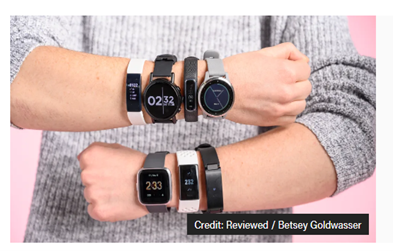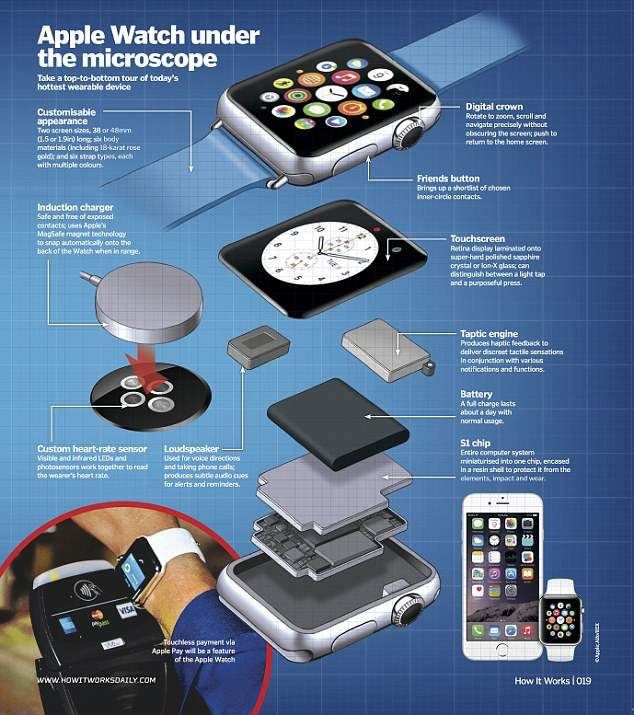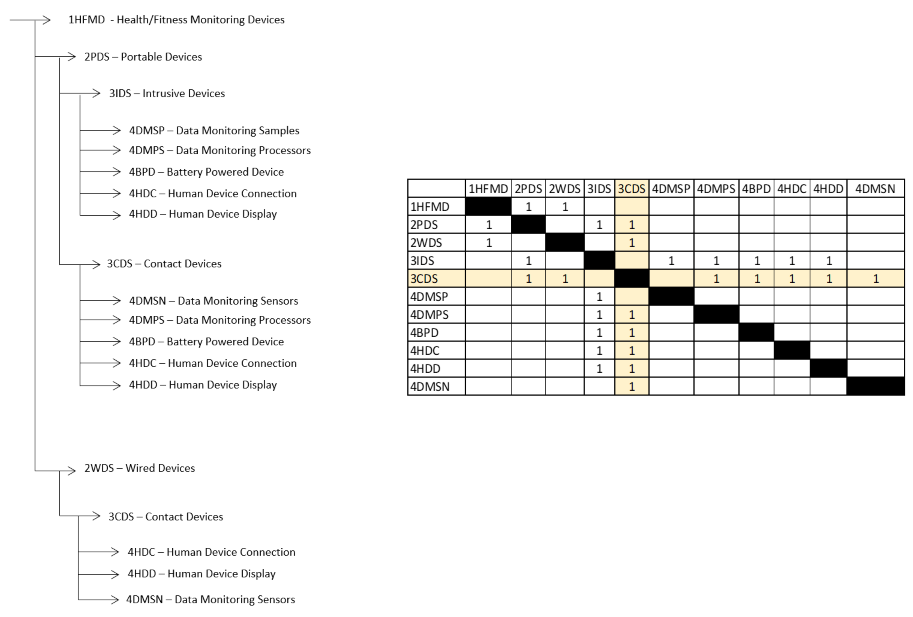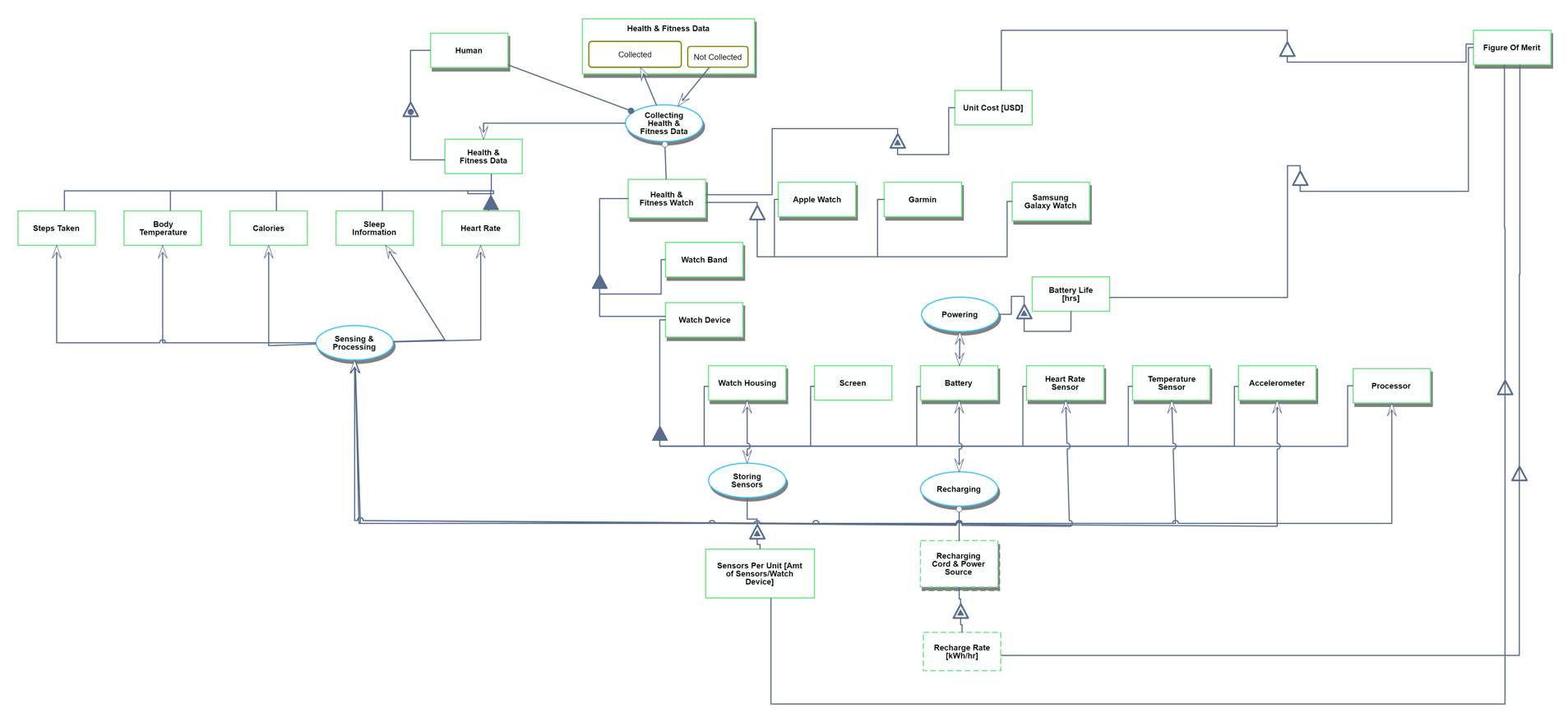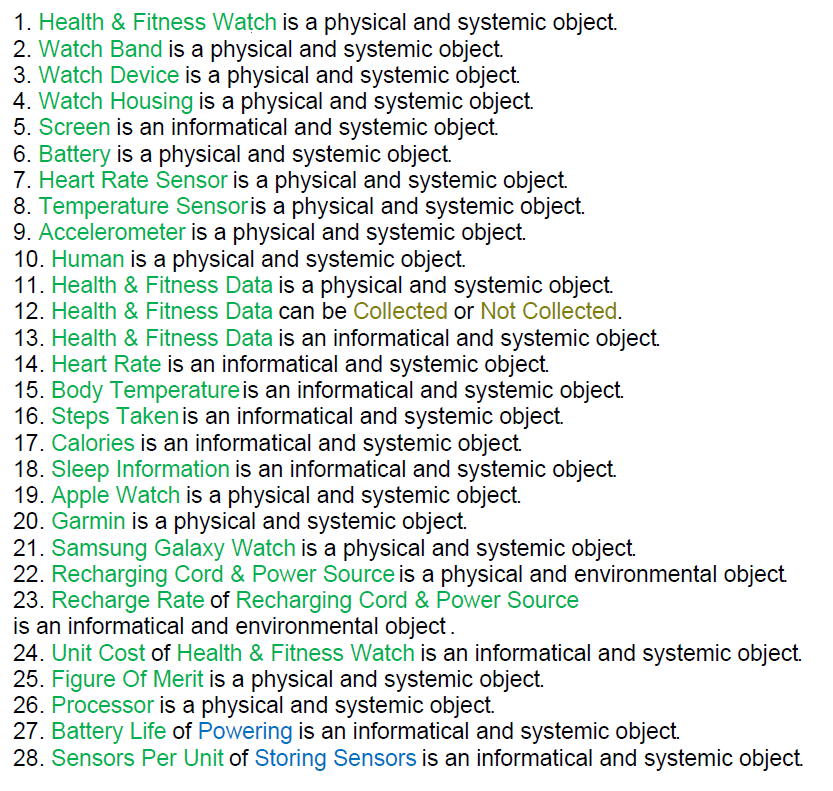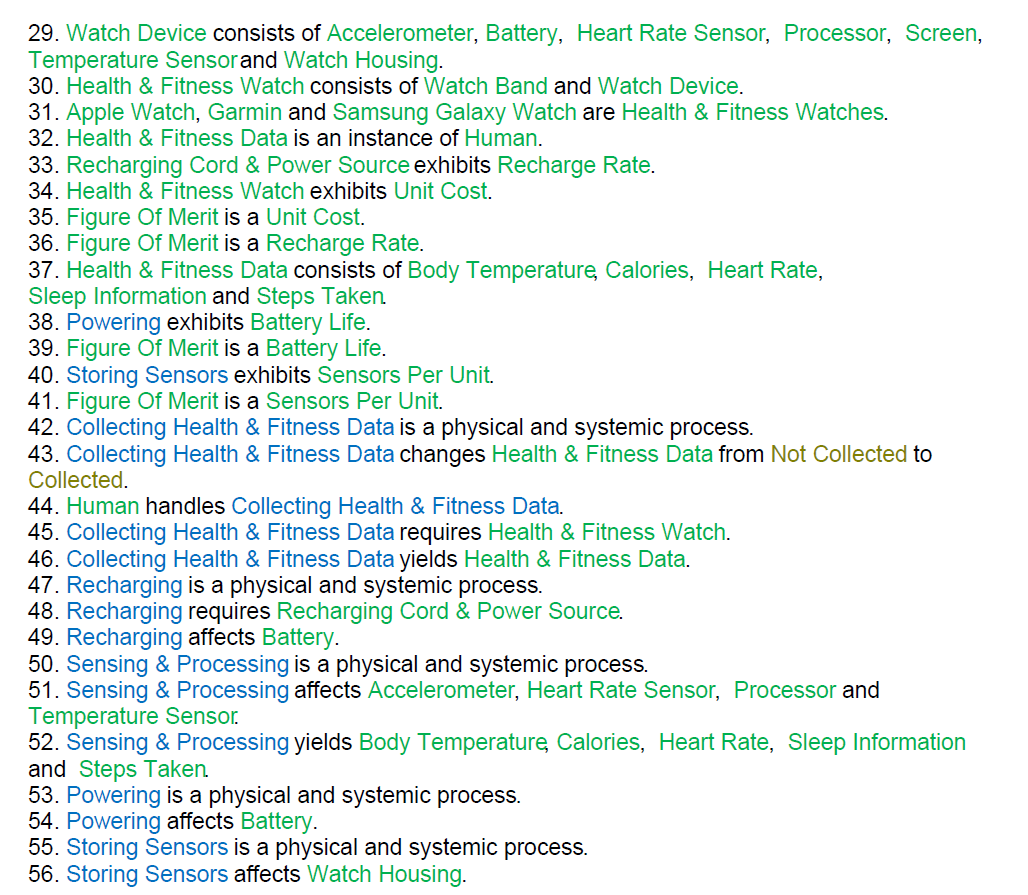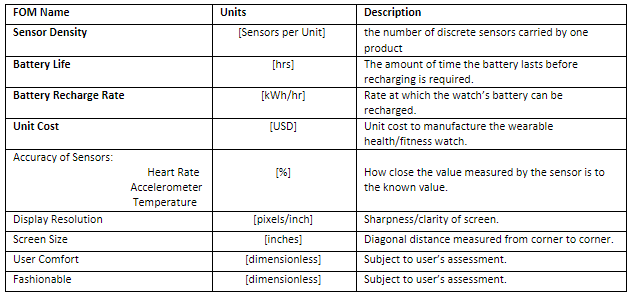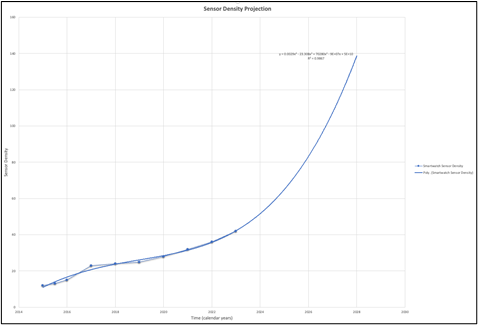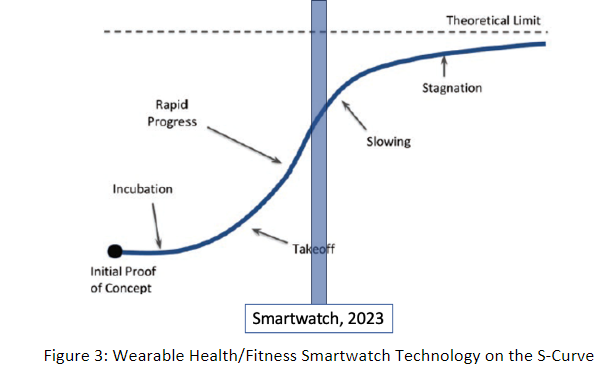Difference between revisions of "Wearable Health Fitness Watches"
| Line 16: | Line 16: | ||
=Design Structure Matrix (DSM) Allocation= | =Design Structure Matrix (DSM) Allocation= | ||
The roadmap hierarchy to the left on the figure below shows the location of the wearable health/fitness monitoring device (2WHFWT). | |||
The DSM shows the 2WHFWT and its relationship to the level 1 item above and respective level 3 components. The level 2 health/fitness devices are separated as being wired components and wearable (non-wired) components (watches). | |||
[[File:DSM 1 Team 10.png]] | [[File:DSM 1 Team 10.png]] | ||
Revision as of 17:18, 12 October 2023
Roadmap Overview
Wearable health/fitness technology has been around since 1268, when the first documented use of eyeglasses was recorded. While wearable health/fitness technology has come a long way since 1268, it was only in the last two decades that wearable health/fitness technology has become mainstream and widely used. The initial and generally adopted wearable health/fitness technology that hit the market in 2003 came in the form of watches, particularly the Garmin Forerunner 101, which was equipped with technology that measured speed, distance, pace, and calories burned. It would be almost another decade before smartwatches with health/fitness sensors integrated into them would be available. When smartwatches with health/fitness technology appeared in the early 2010s, they became almost an overnight sensation. Smartwatches with health/fitness technology have become wildly popular because they allow the wearer to track their health/fitness levels with a single device around their wrist. In addition, smartwatches are multi-purpose with other functionalities the wearer may use, and they serve as both a fashion and status statement.
Today wearable health/fitness technology has morphed to include smart jewelry such as rings and bracelets; for this technology roadmap, the focus will specifically be on health/fitness technology in the form of smartwatches.
The unique identifier for this technology road map is: 2WHFWT - Wearable Health/Fitness Smartwatch Technology.
This indicates that we are dealing with a “level 2” roadmap at the product level where “level 1” would indicate a market-level roadmap, “level 3” would represent the subcomponent roadmap, and “level 4” would indicate an individual component roadmap. At the product level, wearable health/fitness smartwatches typically comprise a watch band and a watch device. The watch device includes a housing unit, screen, battery, heart rate sensor, temperature sensor, accelerometer, and computer processing unit.
Note, the graphic above is specific to the Apple Watch product and is meant to serve as an example of all the components involved in a Health/Fitness smartwatch.
Design Structure Matrix (DSM) Allocation
The roadmap hierarchy to the left on the figure below shows the location of the wearable health/fitness monitoring device (2WHFWT). The DSM shows the 2WHFWT and its relationship to the level 1 item above and respective level 3 components. The level 2 health/fitness devices are separated as being wired components and wearable (non-wired) components (watches).
Roadmap Model using OPM
Below is an Object-Process-Diagram (OPD) of the health/fitness smartwatch technology (2WHFWT) roadmap. This diagram captures the main object of the roadmap (Health/fitness Smartwatch), its various instances, including the main competitors, its decomposition into components and subsystems (sensors, processor), its characterization by Figures of Merit (FOMs) as well as the main processes (collecting health/fitness data, sensing/processing, powering, etc).
An Object-Process-Language (OPL) description of the roadmap scope is auto-generated and provided below. It reflects the same content as the previous figure but in a formal natural language.
Figures of Merit (FOM)
The table below shows a list of FOMs by which health/fitness smartwatches can be assessed. The first four (shown in bold) are mapped in the Object-Process-Model above.
The Figure of Merit selected for this analysis is sensor density: the number of discrete sensors carried by one product, in units of “sensors per unit”. Figure 1 below presents this FOM for leading market technologies over the past 10 years.
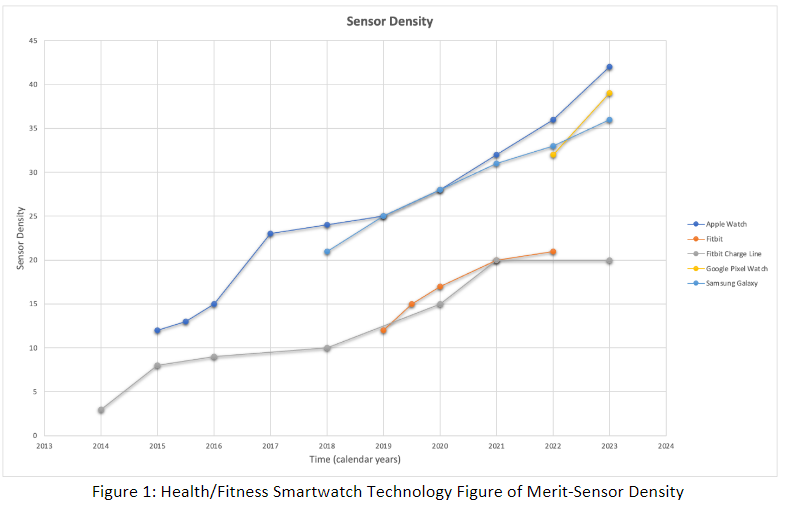
Fitbit sensor densities were discarded from further analysis for modeling and projection purposes, as they were assessed to be within a separate (and less technologically complex) subset of wearable health/fitness devices: fitness trackers.
Despite a relatively short time horizon and limited data, projections for continued sensor density growth were modeled using multiple quantitative methods, including linear, exponential, polynomial, and least squares regression analysis.
Figure 2 below adds a best-fit trendline for health/fitness smartwatch sensor density and projects continued exponential growth over the next 5 years.
Technological constraints and market analysis were also considered for a quantitative analysis. While quantitative projections showed continued exponential increases in the sensor density FOM fitting the “rapid progress” portion of the classic S-curve, several theoretical constraints have been applied in this model, significantly reducing growth as a theoretical limit in the range of 58 is approached. This would represent approximately 40% growth in sensor density relative to the 2023 market aggregate of 39. There are two primary constraints on continued improvement driving this theoretical limit:
- Battery Life: The use case for this technology is a portable wearable device. This places significant size and weight restrictions on design. Battery life has long been a leading constraint for health/fitness smartwatch design and market appeal. The rapid addition of new sensors, functions, and processing requirements comes with increased power consumption rates placing additional strain on battery life. Extensive market research indicates customers won’t tolerate a battery life below a ~1-day functional cycle, and we are approaching that limit where this becomes a constraint. Data on battery performance is highly variable, and performance varies greatly with use; however, the leading models currently on the market advertise a battery life of 18 hours. Advances in processing technology and efficiency may extend the continued growth of this FOM, until breakthroughs improving upon lithium polymer or lithium-ion batteries, or mobile and faster recharging options, are achieved.
- Sensor & Function Saturation: There is a theoretical limit to the amount of data that can be applied in a meaningful way that translates to value customers are willing to pay for. Most recent functional additions have been centered on the medical and fitness fields (heart rate, body mass index, blood oxygen); using standard medical visits and assessments as a benchmark, we are fast approaching sensor and function saturation for the general population.
Figure 3 below presents our qualitative projection with a market aggregate line in green, and our projection in red.
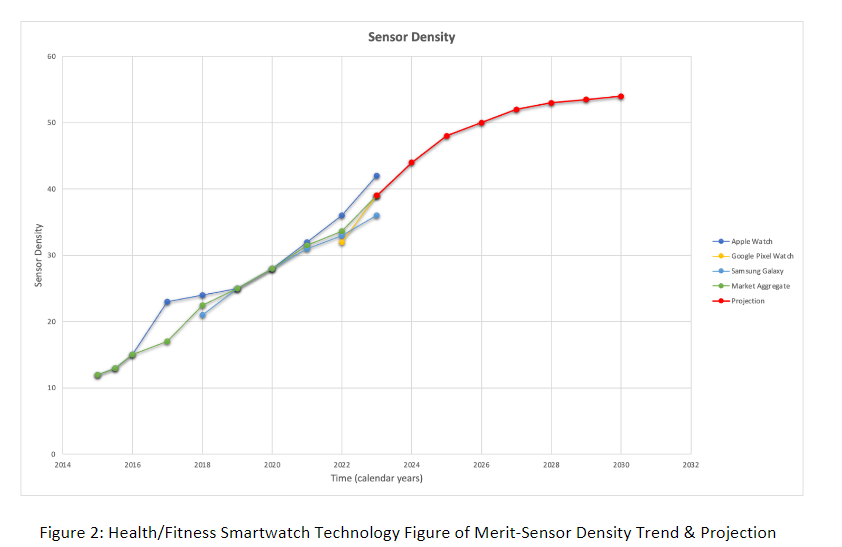
This is a very interesting time for wearable health/fitness device technology and smartwatches in particular. Figure 4 below presents our placement of the health/fitness smartwatch on the technology lifecycle (de Weck, 2022), currently in “Rapid Progress” but projecting the slowing phase may arrive within the next 5 to 10 years.
While known constraints have led us to place a theoretical limit on the continued growth of sensor density, several potential growth factors have the potential to extend both the duration of rapid growth and the theoretical limit of sensor density. Health/fitness smartwatches carry significant instrumentation and capabilities; however, they also serve as a powerful integrator of other technologies into a single wearable device. This allows external advancements in connectivity, machine learning and artificial intelligence, and processing to drive new functions into the relatively compact smartwatch device.
